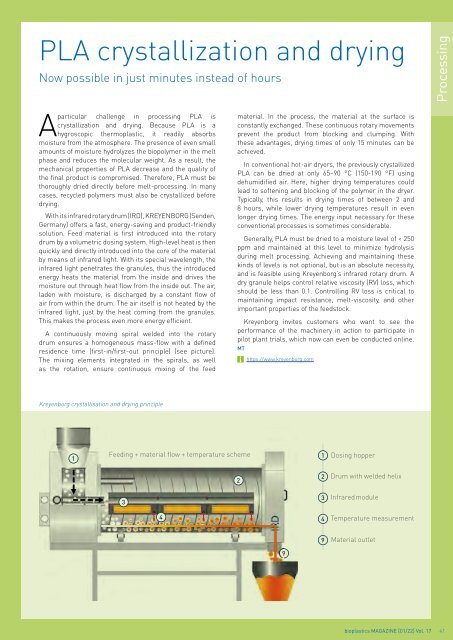issue 01/2022
Highlights: Automotive Foam Basics: Biodegradation
Highlights:
Automotive
Foam
Basics: Biodegradation
You also want an ePaper? Increase the reach of your titles
YUMPU automatically turns print PDFs into web optimized ePapers that Google loves.
PLA crystallization and drying<br />
Now possible in just minutes instead of hours<br />
Processing<br />
A<br />
particular challenge in processing PLA is<br />
crystallization and drying. Because PLA is a<br />
hygroscopic thermoplastic, it readily absorbs<br />
moisture from the atmosphere. The presence of even small<br />
amounts of moisture hydrolyzes the biopolymer in the melt<br />
phase and reduces the molecular weight. As a result, the<br />
mechanical properties of PLA decrease and the quality of<br />
the final product is compromised. Therefore, PLA must be<br />
thoroughly dried directly before melt-processing. In many<br />
cases, recycled polymers must also be crystallized before<br />
drying.<br />
With its infrared rotary drum (IRD), KREYENBORG (Senden,<br />
Germany) offers a fast, energy-saving and product-friendly<br />
solution. Feed material is first introduced into the rotary<br />
drum by a volumetric dosing system. High-level heat is then<br />
quickly and directly introduced into the core of the material<br />
by means of infrared light. With its special wavelength, the<br />
infrared light penetrates the granules, thus the introduced<br />
energy heats the material from the inside and drives the<br />
moisture out through heat flow from the inside out. The air,<br />
laden with moisture, is discharged by a constant flow of<br />
air from within the drum. The air itself is not heated by the<br />
infrared light, just by the heat coming from the granules.<br />
This makes the process even more energy efficient.<br />
A continuously moving spiral welded into the rotary<br />
drum ensures a homogeneous mass-flow with a defined<br />
residence time (first-in/first-out principle) (see picture).<br />
The mixing elements integrated in the spirals, as well<br />
as the rotation, ensure continuous mixing of the feed<br />
material. In the process, the material at the surface is<br />
constantly exchanged. These continuous rotary movements<br />
prevent the product from blocking and clumping. With<br />
these advantages, drying times of only 15 minutes can be<br />
achieved.<br />
In conventional hot-air dryers, the previously crystallized<br />
PLA can be dried at only 65–90 °C (150-190 °F) using<br />
dehumidified air. Here, higher drying temperatures could<br />
lead to softening and blocking of the polymer in the dryer.<br />
Typically, this results in drying times of between 2 and<br />
8 hours, while lower drying temperatures result in even<br />
longer drying times. The energy input necessary for these<br />
conventional processes is sometimes considerable.<br />
Generally, PLA must be dried to a moisture level of < 250<br />
ppm and maintained at this level to minimize hydrolysis<br />
during melt processing. Achieving and maintaining these<br />
kinds of levels is not optional, but is an absolute necessity,<br />
and is feasible using Kreyenborg’s infrared rotary drum. A<br />
dry granule helps control relative viscosity (RV) loss, which<br />
should be less than 0.1. Controlling RV loss is critical to<br />
maintaining impact resistance, melt-viscosity, and other<br />
important properties of the feedstock.<br />
Kreyenborg invites customers who want to see the<br />
performance of the machinery in action to participate in<br />
pilot plant trials, which now can even be conducted online.<br />
MT<br />
https://www.kreyenborg.com<br />
Kreyenborg crystallisation and drying principle<br />
1<br />
Feeding+material flow+temperature scheme<br />
1 Dosing hopper<br />
2<br />
2<br />
Drum with weldedhelix<br />
3<br />
3<br />
Infraredmodule<br />
4<br />
4<br />
Temperature measurement<br />
9<br />
Material outlet<br />
9<br />
bioplastics MAGAZINE [<strong>01</strong>/22] Vol. 17 41

















